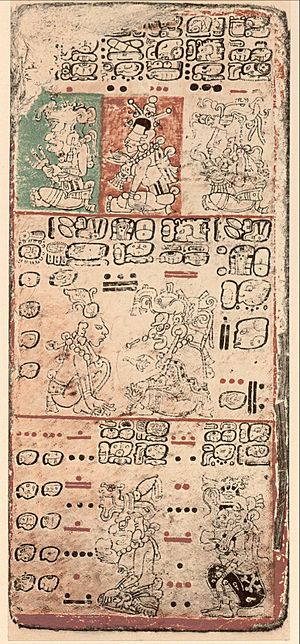Maya languages facts for kids

The Maya languages are a group of languages spoken in Central America. These languages are used by at least 6 million Maya people. Most of them live in countries like Guatemala, Mexico, and Belize. In 1996, Guatemala officially recognized 21 different Maya languages. Mexico recognizes eight more.
The Maya language family is one of the most studied language groups in the Americas. Today's Maya languages developed from a much older language called Proto-Mayan. This ancient language was likely spoken over 5,000 years ago. Scientists have been able to partly figure out what Proto-Mayan was like.
Contents
What are Maya Languages?
The Maya languages are a group of related languages. They all come from a single ancient language. Think of it like how Spanish, French, and Italian all came from Latin. These languages are spoken by the Maya people. They live in a region called Mesoamerica. This area includes parts of southern Mexico and Central America.
Where are Maya Languages Spoken?
Most Maya language speakers live in Guatemala. Many also live in southern Mexico. Smaller groups of speakers are found in Belize, El Salvador, and Honduras. Each country has its own mix of Maya languages. For example, Guatemala has many different ones. Mexico has a few main ones.
How Many Maya Languages Exist?
There are about 30 different Maya languages spoken today. Some are spoken by millions of people. Others are only spoken by a few thousand. Each language is unique. They have their own sounds, words, and grammar rules. But because they are related, they share some similarities.
History of Maya Languages
The history of Maya languages goes back thousands of years. They developed from a single ancient language. This language is called Proto-Mayan. Over time, groups of people moved to different areas. Their language slowly changed. This led to the many different Maya languages we hear today.
Ancient Maya Writing
The ancient Maya people had a very advanced writing system. They used pictures and symbols called hieroglyphs. These hieroglyphs were carved into stone monuments. They were also painted on pottery and in special books called codices. This writing system was used to record history, myths, and important events. It helps us understand their ancient languages.
How Languages Changed Over Time
As Maya communities grew and spread out, their languages changed. New words were created. Old words changed their meaning. Different dialects formed. Eventually, these dialects became separate languages. This process is called language diversification. It's how all language families grow.
Understanding Maya Languages
Maya languages are known for some interesting features. For example, many of them use a special way to form words. They add small pieces to the beginning or end of words. This changes their meaning. This is called an "agglutinative" language.
Sounds and Grammar
Maya languages have unique sounds. Some sounds are not found in English. They also have different grammar rules. For instance, the order of words in a sentence might be different. They often use special ways to show who is doing an action. Learning a Maya language can be a fun challenge.
Modern Use of Maya Languages
Today, Maya languages are still very important. They are used in daily life. People use them at home, in their communities, and sometimes in schools. Efforts are being made to keep these languages alive. This includes teaching them to younger generations. It also involves creating books and media in Maya languages.
Images for kids
-
Classic period Maya glyphs in stucco at the Museo de sitio in Palenque, Mexico
-
Yucatec Maya writing in the Dresden Codex, ca. 11–12th century, Chichen Itza
-
Dinner menu in Kaqchikel, Antigua, Guatemala
See also
 In Spanish: Lenguas mayenses para niños
In Spanish: Lenguas mayenses para niños





